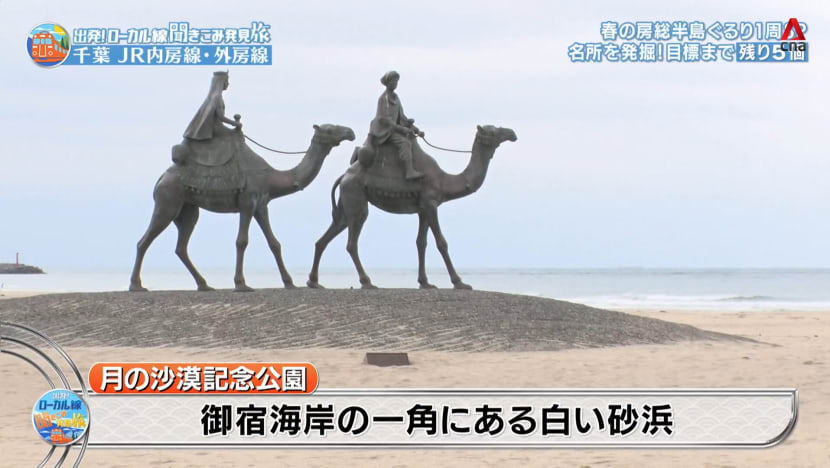Road Trip On Uchibo And Sotobo Line - Part 3

Katsuura's bright red ramen dish with chilli oil, a 120-million-yen bathtub made of pure gold and a white sand beach with a statue linked to a Japanese folk song are among this week's highlights.
Two pairs of travellers continue their three-day journey of enquiry and discovery on the Uchibo and the Sotobo railway lines in Boso Peninsula, Chiba Prefecture. On the second day, the first team of Gitan Otsuru and Jun Shibuki passes the baton to Mami Kumagai and Taku Suzuki, who will take over the next half of the trip. The latter duo has already secured their accommodation for the second night at Katsuura Hotel Mikazuki and start looking for a place which sells Katsuura tantanmen, a local speciality. There are 42 shops in the city which sell this local speciality.
The team asks a local who suggests a restaurant called Keyaki. Katsuura tantanmen is different from the regular tantanmen with sesame soup. The Katsuura version has a soy sauce-based soup with chilli oil, which explains its red colour. Lots of minced pork and onions fried in chilli oil are added, together with garlic. As for the fried version, thick tantanmen soup is poured on top of crispy noodles.
The next morning, the duo starts the day with a refreshing hot spring bath that has sodium chloride and hydrogen carbonate. Hotel guests can also soak in a special luxurious bathtub made of pure 18-karat gold. It cost 120 million yen at the time of its installation.
Mr Suzuki and Ms Kumagai then take the train from Katsuura Station and get off Onjuku. Their next train from here is about two hours later at 11.30am. A resident recommends they check out two places - a special monument and a white sand beach at Ajiro Bay with a “Tsuki no Sabaku” statue, which commemorates a Japanese folk song inspired by the beach. The statue was installed at the Tsuki no Sabaku Memorial Park on Onjuku Beach in 1969. It depicts a prince and princess riding camels, as described in the children’s song Tsuki no Sabaku written by Masao Kato. It is said that the poet often visited this area to recuperate from his illness. He thought that the white sand beach at Onjuku looked like a vast desert and thus came up with the song.
The travellers then head to the monument recommended earlier. It is known as the “Birthplace Monument of Traffic and Friendship between Japan, Spain and Mexico”. More than 400 years ago during the early Edo period, a Spanish ship sailing from the Philippines to Mexico got stranded on Onjuku Beach after a typhoon. “Ama” divers, along with other locals, worked together to rescue more than 300 people. The monument was built in 1928 to commemorate that event and the friendly ties between Japan, Spain and Mexico.
Ms Kumagai and Mr Suzuki then make a quick stopover at Mikado, before going to Oami Station. They decide to spend about two hours here and take the train departing at 4.20pm. They are hungry and a local they speak to mentions Kurataya Shokudo. Opened in 1953, the Showa-era restaurant is run by an elderly couple, their son and daughter-in-law. The couple used to run a small inn, but they switched to a restaurant due to declining guest numbers. Their recipes have not changed since the old days. The restaurant’s speciality ramen has a light soy sauce-based soup made with simmered pork belly, onions and carrots. The roasted pork is also homemade. The grilled meat set meal is served with thick pork loin. They use a special sauce made with soy sauce, sake and a lot of garlic which enhances the flavour of the meat.
The two travellers’ next stop is Hon-Chiba Station. Many government offices are located in this district. A resident tells the pair to go to the Chiba City Folk Museum, which was constructed on the former site of Chiba Castle in 1967. The building resembles the style of the Odawara Castle of the Hojo clan. They were closely connected to Chiba Tsuneshige, the lord who ruled the area. In the museum, armours, swords and firearms are displayed. This area is also famous for its cherry blossoms. Every year, the Chiba Castle Cherry Blossom Festival is held here.
Ms Kumagai and Mr Suzuki finally take the Sotobo Line train to Chiba Station. The terminal is the goal of this trip around Boso Peninsula. A resident suggests the travellers visit the Chiba City Museum of Science. It is located inside Qiball, a commercial complex that opened in 2007. The museum has a large, state-of-the-art planetarium. Visitors can gaze at millions of stars here.
Tips:
1) A must-try delicacy of Chiba Prefecture is a spicy ramen dish called Katsuura tantanmen
2) Visit Onjuku’s famous white sand beach with the Tsuki no Sabaku statue linked to a folk song












